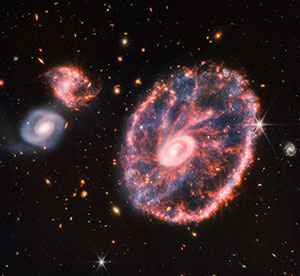UW Planetarium Will Alter Schedule Lineup In April
The University of Wyoming Harry C. Vaughan Planetarium will switch its lineup around during April.
“We are changing up our schedule a bit by moving our music programs to Friday evenings at 7 p.m.,” says Max Gilbraith, the planetarium’s coordinator. “Our live science talks will be Saturdays at 7 p.m.; full-dome films will continue on Saturdays at 2 p.m.; and even-numbered Tuesdays at 7 p.m. are our ‘Wyoming Skies’ constellation tours.”
To get tickets or receive more information about programs, email planetarium@uwyo.edu or leave a voicemail and a call-back phone number at (307) 766-6506. Tickets are $5 for the public and $3 for students, senior citizens, veterans, first responders and those under 18. Seating is free for children under 5.
Reservations or pre-purchase is not required, and walk-ins are welcome. Tickets can be purchased online with a credit card, reserved by email or voicemail, or purchased at the start of the show. Cash or check is accepted at the door. The planetarium, which seats 58, is in the basement of the Physical Sciences Building. Seating is on a first-come, first-served basis outside of designated ADA/wheelchair seating.
To pay for tickets with a credit card, go to https://www.uwyo.edu/uwplanetarium/ticket.aspx. For a group larger than six, email the planetarium for a private show at https://uwyo.sjc1.qualtrics.com/jfe/form/SV_bKuqIynOn7gFK2F. Tickets for private shows are the same as the public programs.
A film and special live talk for audiences will be featured each week. All programs are approximately an hour in length. As time allows, a portion of the show also may focus on a live sky tour or supporting information related to the film’s topic.
The April schedule is:
— Saturday, April 1, 2 p.m.: “Max Goes to the Moon,” a full-dome movie. Max, the dog, and a young girl named Tori take the first trip to the moon since the Apollo era.
— Saturday, April 1, 7 p.m.: “Flat Earth.” The planetarium hosts, once a year, a presentation from the unofficial Flat Earth Society.
— Tuesday, April 4, 7 p.m.: “Wyoming Skies.” The program provides an exploration of the stars, constellations, planets, meteor showers and other celestial phenomena visible from Wyoming for the season.
— Friday, April 7, 7 p.m.: “Liquid Sky: Pink Floyd’s ‘The Dark Side of the Moon,’” a music-based light show. Enjoy the classic album, now in its 50th year, in 5.1 surround sound. The 4K-resolution planetarium sky will become a canvas of color, patterns and movement with cutting-edge music visualization software and live VJ talent.
— Saturday, April 8, 2 p.m.: “The Sun: Our Living Star,” a full-dome movie. The sun consumes 600 million tons of hydrogen each second and is 500 times as massive as all of the planets combined. Viewers will discover the secrets of the sun and experience never-before-seen images of its violent surface.
— Saturday, April 8, 7 p.m.: “Science of Sci-Fi: ‘The Core,’” a full-dome movie. Can Aaron Eckhart save Earth? Can we save the science from the fiction? The planetarium hosts a “Mystery Science Theater 3000”-style live review of the 2003 classic.
— Friday, April 14, 7 p.m.: “Liquid Sky: Women Who Rock,” a music-based light show. Enjoy a trip through rock — past to present — of the best female-fronted artists in 5.1 surround sound. The 4K-resolution planetarium sky will become a canvas of color, patterns and movement with cutting-edge music visualization software and live VJ talent.
— Saturday, April 15, 2 p.m.: “Europe to the Stars,” a full-dome movie. This film takes viewers on an epic journey behind the scenes at the most productive ground-based observatory in the world — the European Southern Observatory — revealing the science, history, technology and the people.
— Saturday, April 15, 7 p.m.: “James Webb Space Telescope.” The next-generation space telescope launched in 2021. The epic mission to send a tennis court-sized observatory past the moon will reveal the mysteries of the universe like never before. This program will detail the exciting science objectives and the knuckle-biting engineering feats that have gone into our next eyes in the sky.
— Tuesday, April 18, 7 p.m.: “Wyoming Skies.” The program provides an exploration of the stars, constellations, planets, meteor showers and other celestial phenomena visible from Wyoming for the season.
— Friday, April 21, 7 p.m.: “Liquid Sky: R&B,” a music-based light show. Enjoy this lovesick playlist of the past decades’ best rhythm and blues artists in 5.1 surround sound. The 4K-resolution planetarium sky will become a canvas of color, patterns and movement with cutting-edge music visualization software and live VJ talent.
— Saturday, April 22, 2 p.m.: “From Earth to the Universe,” a full-dome movie. This film takes the audience out to the colorful birthplaces and burial grounds of stars and still farther out beyond the Milky Way to the unimaginable immensity of myriad galaxies.
— Saturday, April 22, 7 p.m.: “Earth Day.” Take a journey around and above Earth to see its beauty while learning about our planet’s geologic, oceanic, atmospheric and biological processes.
— Friday, April 28, 7 p.m.: “Liquid Sky: Pop,” a music-based light show. Listen to today’s top artists in 5.1 surround sound. The 4K-resolution planetarium sky will become a canvas of color, patterns and movement with cutting-edge music visualization software and live VJ talent.
— Saturday, April 29, 2 p.m.: “Back to the Moon for Good,” a full-dome movie. This film opens with the first era of space exploration in the late 1960s and early 1970s. Viewers will learn what that era of landers and orbiters taught the world about the moon.
— Saturday, April 29, 7 p.m.: “Mars.” The Red Planet is host to many questions: Did Mars used to be like Earth? Did it once harbor life? Could it still support life today? And, is it a future home for humans? Landers, rovers, probes and satellites have returned data to Earth for decades, and we have more clues every day.
For more detailed descriptions of these programs, go to www.uwyo.edu/physics/planetarium/schedule.html.

